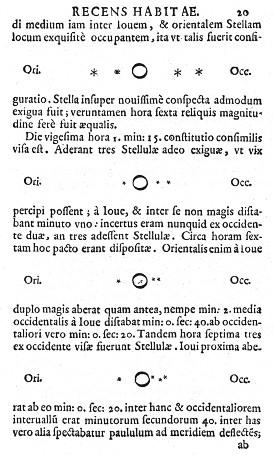The telescope was invented at the beginning of the 17th century in the Netherlands, but the use of it for astronomical observations was popularised by Galileo (1564–1642) through the publishing of Sidereus Nuncius in 1610. This short book showed the reader mountains in the Moon, faint stars that formed the Milky Way and four natural satellites of Jupiter.
Soon after that the discoveries of Saturn’s strange shape, for which its rings are responsible, the phases of Venus, and sunspots were made, but not all of them can be attributed to Galileo. All in all, thanks to the telescope, it was proved that there are other centres of motion (for example Jupiter for its moons), and thus new arguments appeared supporting Copernicus’s system, and supporting the idea that celestial bodies are probably formed from a material that is not significantly different from earth. When in 1665 Robert Hooke presented his observations of the Moon with the use of a telescope, he stated what follows: ‘...it being very probable, that the Moon has a principle of gravitation, it affords an excellent distinguishing Instance in the search after the cause of gravitation, or attraction ... for ... the Moon has an attractive principle, whereby it is not only shap'd round, but does firmly contain and hold all its parts united, though many of them seem as loose as the sand on the Earth ... therefore some ... principle must be thought of, that will agree with all the secundary as well as primary Planets.’ In other words, it became clear that the whole universe is formed by the same forces.
 A page from Galileo's Sidereus Nuncius, Venice 1610
A page from Galileo's Sidereus Nuncius, Venice 1610
The nature of these forces was discovered by Isaac Newton (1642–1727), who published in 1687 Mathematical Principles of Natural Philosophy, or Principia. In this work he presents the fundaments of mechanics and proves that Kepler’s laws result from the law of universal gravitation. Newton also proved that comets are celestial bodies that move in conic sections. Having followed this trail, Edmond Halley (c. 1656–1742) correctly predicted the return of a comet that was observed in 1531, 1607, and 1682. Halley’s prediction proved correct in 1758 and became a great success of Newton’s sky mechanics.
In the 18th century it became a fully developed theory, the basis of which was not geometry, as it was even in the case of Newton, but mathematical analysis. It was thanks to works by Jean le Rond d’Alembert (1717–1783), Alexis Clairaut (1713–1765), Leonhard Euler (1707–1783), Joseph Louis Lagrange (1736–1813), Pierre Simon de Laplace (1749–1827) and others that this theory became increasingly successful and explained more and more precisely motions of celestial bodies in the Solar System. Another great success of the sky mechanics was the discovery of Neptune in 1846, which was achieved on the basis of calculations by Urbain Jean Joseph Le Verrier (1811–1877) and, independently, by John Couch Adams (1819-1892).
Together with the progress of the theory, development of methods of observation took place. Galileo’s telescope produced an upright image, but in 1611 Kepler proposed a different design with a larger field of vision and producing an inverted image. In the first half of the 17th century a Keplerian telescope was used to increase the accuracy of positional measurements: the eyepiece micrometer was invented. Traditional astrometry, in which the measurements were made with the use of instruments designed for naked eye observations, and which was still cultivated after Tycho Brahe by an astronomer from Gdańsk, namely Johannes Hevelius (1611–1689), was discarded.
One of the most important successes of the new observational astronomy was the identification of light aberration phenomenon (a direct confirmation of the heliocentric motion of Earth postulated by Copernicus) in 1728 by an Englishman, James Bradley (1693–1762). One hundred years later astrometry achieved another spectacular success: in 1836–1837 Wilhelm Struve (1793–1864) and F. W. Bessel (1784–1846) for the first time measured the distance to the nearby stars.
In 1660s a Scot, James Gregory, and Newton independently proposed a new type of telescope – a reflector. One hundred years later this device was successfully used by William Herschel (1738–1822) in his astronomical studies. Herschel himself constructed reflectors with diameters of 18 inches and 4 feet in diameter mirrors. Herschel became famous owing to his discovery of Uranus in 1781, but his equally important achievement was pointing out to astronomers new directions of study mainly thanks to his systematic observations of nebulae, star clusters and double stars. These studies were later continued by his son, John Herschel (1792–1871) with reference to the southern sky.
Further reading
- The Cambridge Concise History of Astronomy, ed. by M. Hoskin (Cambridge, 1999).
- Planetary astronomy from the Renaissance to the rise of astrophysics. Part A: Tycho Brahe to Newton, ed. by R. Taton and C. Wilson (Cambridge, 1989).
- Planetary astronomy from the Renaissance to the rise of astrophysics. Part B: The eighteenth and nineteenth centuries, ed. by R. Taton and C. Wilson (New York, 1995).
 English (United Kingdom)
English (United Kingdom)  Polski (PL)
Polski (PL) 





